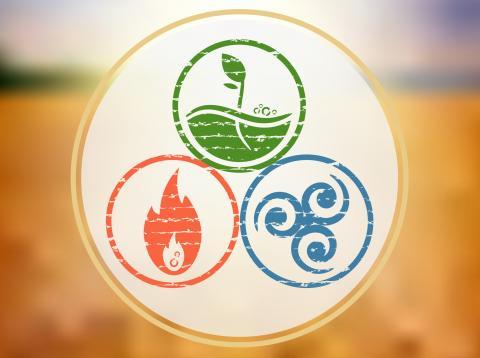
Do you have thick hair, thin hair, or maybe more coarse hair?
Are you talkative or not?
Prone to anger, fear, or escape in a stressful situation?
Your answers to questions like these form your unique balance of the three doshas according to Ayurvedic theory. Doshas are biological energetic substances that function within one’s body to maintain health and life. The doshas – which are always changing and adapting to the conditions in one’s life – correspond with the three of the five elements that are also constantly changing. The elements of air, fire, and water (which give the respective qualities to the wind, sun, and moon) shift in accordance with one another, whereas the last two of the five life-giving elements, ether and earth, generally remain more constant, and change independently and infrequently.
The doshas wax and wane based on what one’s body needs, and also in response to the exterior environment in which we exist at any given part of the day, month, year. The three doshas regulate our essential physiological tissues, the dhatus, as well as our body’s wastes, or malas. The dhatus include plasma, blood, muscle, fat, bone, bone marrow and nerve and reproductive tissue, and the malas include biological wastes such as sweat, urine, and feces.
In Ayurvedic theory, each person is born with a specific constitution, or prakruti. Prakruti governs how one looks, how one’s body metabolizes, and how one responds both emotionally and mentally to various life circumstances. One’s mind-body type or dosha can be roughly identified based on some clues in the body, mind, and environment. One may tend towards one of the three doshas, or may be a combination of mostly two doshas, but because of the balancing nature of the three, one is rarely an even balance of all three doshas. The balance of each of the key qualities associated with the vata, pitta, and kapha doshas is what makes us each unique.
Vata (Air; secondary: ether)
Season: Late fall through early winter – dry, rough, irregular, mobile, cool
Key role: Controls bodily functions of motion, transmission, nerve impulses, and sense perception in the body (blood circulation, breathing, blinking, heartbeat)
Associated parts of the body: colon, bladder, uterus, joints, skin (consequence = gas or bloating)
Physical composition: thin, lean, wiry
Mental composition: quick mind, creative thinker, enjoys spontaneity rather than routine
Emotional composition: restless, anxious, likely to scare rather than anger in a stressful situation
Balance compositions with: routine, warmth, serenity, nourishment
Eating habits: enjoys snacking and nibbling rather than sitting for a big meal, eats “airy” foods like popcorn or apples
Balance diet with: grounding, warm, moist foods, like legumes and root vegetables
Other notable traits: sometimes thirsty; light sleeper/insomnia sometimes present; has brittle fingernails; sex drive comes and goes; spends and shares money
Pita (Fire; secondary: water)
Season: Full-on spring through the peak of fiery fall colors – hot, intense, transformative
Key role: Controls metabolic functions and rapid transformations in the body
Associated parts of the body: digestive secretions, like stomach acid and the liver’s bile (consequence = burping or sweating)
Physical composition: medium bone frames, well proportioned, moles, fair or reddish skin
Mental composition: enjoy taking the lead, setting your own pace, good memory
Emotional composition: likely to anger rather than scare in a stressful situation
Balance compositions with: Cooling, surrendering, moderation
Eating habits: ravenous when hungry, eats “fiery” foods like spicy and hot (temperature) foods
Balance diet with: cooling and soothing foods, like fresh fruits and vegetables
Other notable traits: often thirsty; usually sleeps well; has flexible but strong fingernails; “ready” sex drive; spends money on special items or those necessary for advancement
Kapha (Water; secondary: earth)
Season: Late winter to the birth of spring – heavy, dense, stable, wet
Key role: Controls growth in the body by providing moisture, lubrication, and mass in the body’s membranes, active where there are whitish secretions (consequence = slow or sticky bowel movements)
Associated parts of the body: lungs, mouth, and orifices
Physical composition: solid build, strong frame
Mental composition: slow to make decisions, prefer routine, good organizer
Emotional composition: pensive, stubborn, tends to isolate or “numb out” in times of stress
Balance compositions with: Stimulation, warming, exercise, lightening
Eating habits: can sustain on little food for a long time, eats heavy, “earthy” foods, like breads, starches, and dense sweets
Balance diet with: lighter, crispier foods, like soups and salads
Other notable traits: rarely thirsty; sound, heavy sleeper; has strong, thick fingernails; steady sex drive; prefers to save money
Knowing and understanding your dosha is, in Ayurvedic medicine, the mode of getting to know yourself. Your demeanor and preferences and the habits and tendencies you form are a result of your dosha, and change according to imbalances in your body, which can be a result of environmental conditions (like weather and seasons), foods we eat (elemental consumption) stress, emotions, our own actions, and other life circumstances. The three main doshic states are: balanced or “equilibrium” (which is desirable but can be hard to maintain), increased or “aggravated” (one dosha is more prominent), and decreased or “reduced” (one dosha is less prominent).
Want to learn more about your dosha? You may also want to take this Basmati dosha quiz, or this quick quiz to better understand your dosha, or mind-body type. Basmati also has information about how to choose a yoga practice or the right exercise based on your dosha. As we are currently in the summer season for elevated pitta, allow yourself to surrender to the excitement and energy of summer, and stick to a fresh, cooling, soothing diet. This delicious summer mint-time citrus cooler is a great place to start!
Source:
Morningstar, Amadea. Ayurvedic Cooking for Westerners. Lotus Press: June 25, 1995. Print.








